دانلود کتاب دینامیک سیالات محاسباتی برای جریانهای تراکم ناپذیر Computational Fluid Dynamics for Incompressible Flows
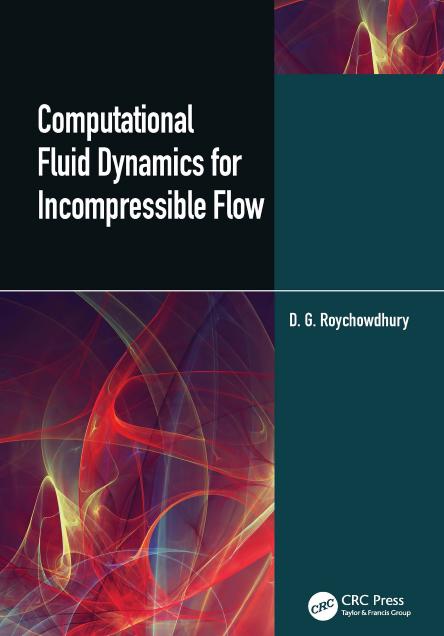
این کتاب در 11 فصل تدوین شده و مقدمات دینامیک سیالات محاسباتی مبتنی بر روشهای اختلاف محدود و حجم محدود به اختصار تشریح شده است.
دانلود کتاب فناوریهای انرژی خورشیدی ،کاربردها و اثرات زیست محیطیPhotovoltaic Solar Energy Conversion Technologies, Applications and Environmental Impacts
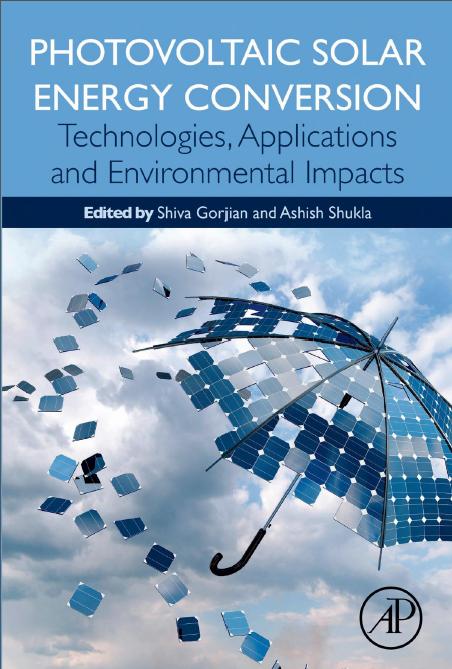
در این کتاب فناوریهای تبدیل انرژی فتوولتائیک و کاربردهای آنها در 13 فصل تشریح شده است.
دانلود کتاب ترمودینامیک و تحلیل سیستمهای انرژی -مسائل حل شده و تمرینها THERMODYNAMICS AND ENERGY SYSTEMS ANALYSIS SOLVED PROBLEMS AND EXERCISES
این کتاب دارای 528 صفحه و 15 فصل می باشد و مسائل حل شده و تمرینهای متعددی در هر یک از فصلهای آن در زمینه های مختلف حتی احتراق و اگزرژی و ... حل شده است.
دانلود کتاب مسائل حل شده در ترمودینامیک و فیزیک آماری Solved Problems in Thermodynamics and Statistical Physics
این کتاب دارای 293 صفحه است و از دو بخش ترمودینامیک و فیزیک آماری مجموعا 13 فصل تشکیل شده و تعداد زیادی نمونه مسائل امتحانی و تمرین های کلاسی در سطح متوسط تا سخت در آن حل شده است. مطالعه آن برای دانشجویان کارشناسی ارشد و دکترا توصیه می شود.
دانلود کتاب مسائل عملی حل شده در مکانیک سیالات SOLVED PRACTICAL PROBLEMS in FLUID MECHANICS

این کتاب دارای 9 فصل زیر می باشد:
1-استاتیک سیالات (9 مسأله)
2-اندازه گیری جریان (6 مسأله)
3-جریانهای تخلیه شوندۀ آزاد (10 مسأله)
4-اصطکاک سیال (14 مسأله)
5-پمپ ها (10 مسأله)
6-جریان چند فازی (12 مسأله)
7-اختلاط سیالات (12 مسأله)
8-جریان ذرات(13 مسأله)
9-رفتارشناسی و سیالات غیرنیوتنی (10 مسأله)
که در هر فصل تعدادی مسأله کاربردی حل شده است. مطالعۀ آن برای دانشجویان کارشناسی و کارشناسی ارشد اکیداً توصیه می شود. انتهای هرفصل تعدادی مسائل حل نشده هم ارائه شده است.
دانلود مقاله تحلیل عددی انتقال حرارت جابجایی از یک هیت سینک پره پینیدار با پین های دارای مقطع بیضوی با یا بدون فوم فلزی بینابینی Numerical Analysis of Convective Heat Transfer From an Elliptic Pin Fin Heat Sink With and Without Metal Foam Insert
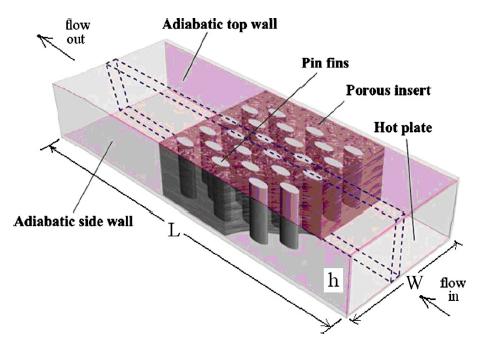
A numerical analysis of forced convective heat transfer from an elliptical pin fin heat sink
with and without metal foam inserts is conducted using three-dimensional conjugate heat
transfer model. The pin fin heat sink model consists of six elliptical pin rows with 3 mm
major diameter, 2 mm minor diameter, and 20 mm height. The Darcy–Brinkman–
Forchheimer and classical Navier–Stokes equations, together with corresponding energy
equations are used in the numerical analysis of flow field and heat transfer in the heat
sink with and without metal foam inserts, respectively. A finite volume code with point
implicit Gauss–Seidel solver in conjunction with algebraic multigrid method is used to
solve the governing equations. The code is validated by comparing the numerical results
with available experimental results for a pin fin heat sink without porous metal foam
insert. Different metallic foams with various porosities and permeabilities are used in the
numerical analysis. The effects of air flow Reynolds number and metal foam porosity and
permeability on the overall Nusselt number, pressure drop, and the efficiency of heat sink
are investigated. The results indicate that structural properties of metal foam insert can
significantly influence on both flow and heat transfer in a pin fin heat sink. The Nusselt
number is shown to increase more than 400% in some cases with a decrease in porosity
and an increase in Reynolds number. However, the pressure drop increases with decreasing
permeability and increasing Reynolds number.
دانلود مقاله بررسی کارایی پدهای سلولزی کولرهای تبخیری Investigating the performance of cellulosic evaporative cooling pads
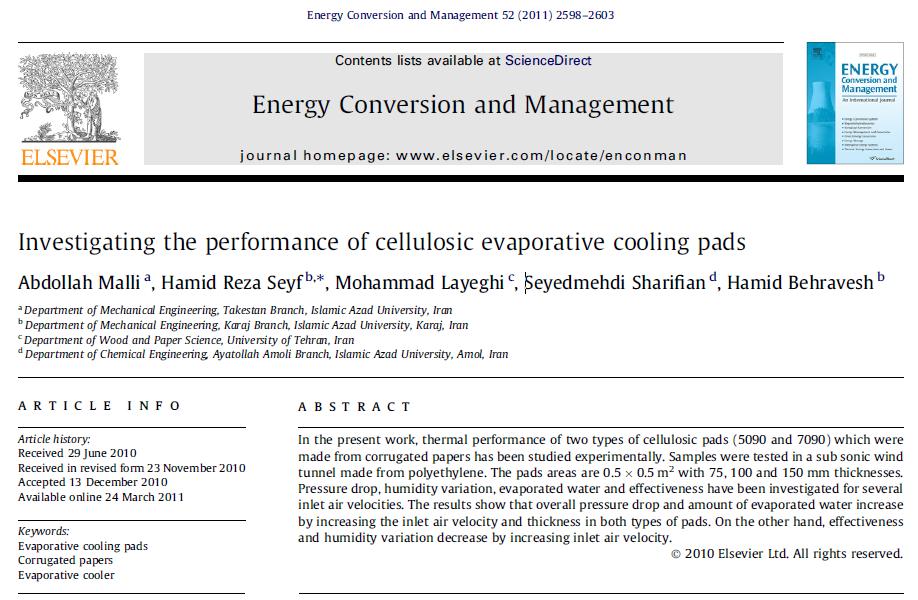
در این مقاله عملکرد سه نوع پد سلولزی موجود در بازار و مورد استفاده در کولرهای تبخیری در یک تونل باد بصورت تجربی بررسی و با یکدیگر مقایسه شده است.
دانلود مقاله مروری برمطالعات عددی هیدرودینامیک جریان توده ای (slug flow) و انتقال حرارت در میکرو لوله ها و میکروکانالها A review on numerical studies of slug flow hydrodynamics and heat transfer in microtubes and microchannels
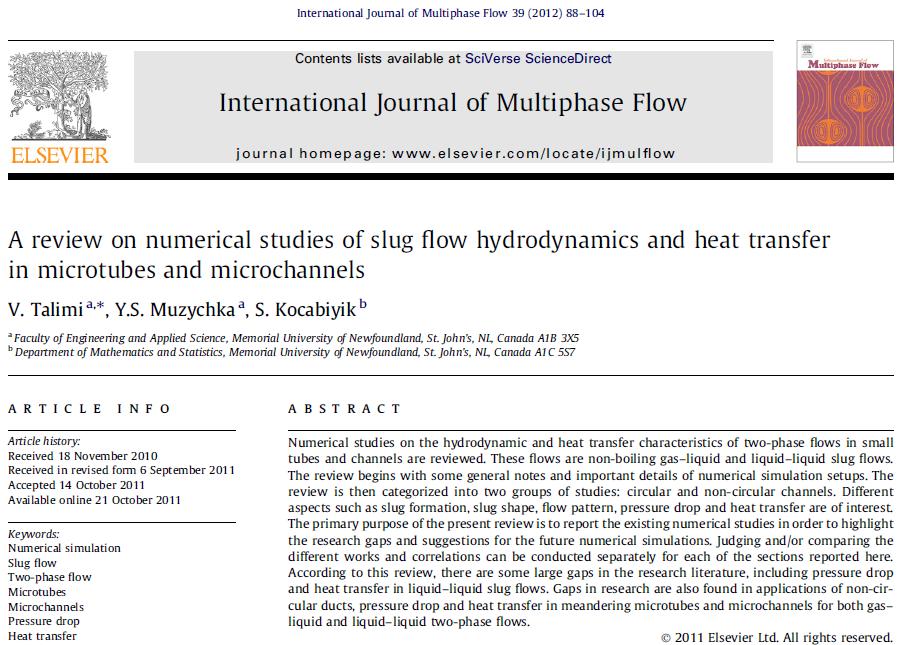
Numerical studies on the hydrodynamic and heat transfer characteristics of two-phase flows in small
tubes and channels are reviewed. These flows are non-boiling gas–liquid and liquid–liquid slug flows.
The review begins with some general notes and important details of numerical simulation setups. The
review is then categorized into two groups of studies: circular and non-circular channels. Different
aspects such as slug formation, slug shape, flow pattern, pressure drop and heat transfer are of interest.
The primary purpose of the present review is to report the existing numerical studies in order to highlight
the research gaps and suggestions for the future numerical simulations. Judging and/or comparing the
different works and correlations can be conducted separately for each of the sections reported here.
According to this review, there are some large gaps in the research literature, including pressure drop
and heat transfer in liquid–liquid slug flows. Gaps in research are also found in applications of non-circular
ducts, pressure drop and heat transfer in meandering microtubes and microchannels for both gas–
liquid and liquid–liquid two-phase flows.
دانلود هندبوک فناوری اسپری حرارتی Handbook of Thermal Spray Technology
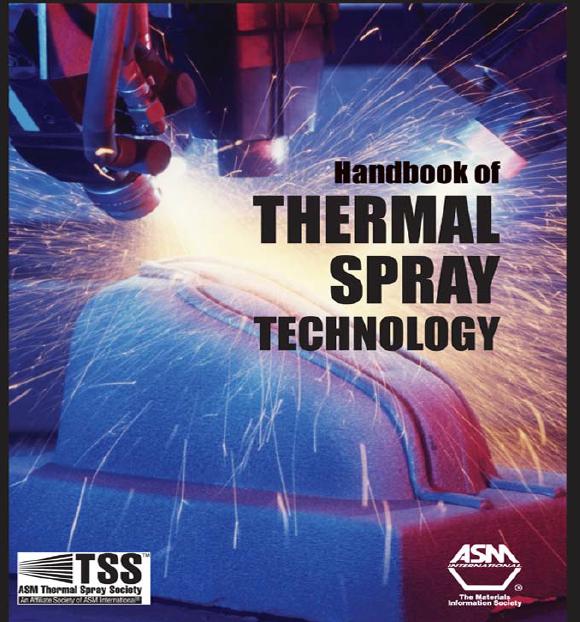
Thermal spray technology encompasses a group of coating processes that provide functional surfaces
to protect or improve the performance of a substrate or component. Many types and forms of materials
can be thermal sprayed—which is why thermal spray is used worldwide to provide protection from corrosion,
wear, and heat; to restore and repair components; and for a variety of other applications.
This handbook is intended to be an extensive reference guide to thermal spray technology. It covers
principles, processes, types of coatings, applications, performance, and testing/analysis. It will
serve as an excellent introduction and guidebook for those who are new to thermal spray. The handbook
provides in-depth coverage and data that will be of great value to specifiers and users of thermal
spray coatings, as well as to thermal spray experts who need additional background in certain
areas. This handbook also was tailored with undergraduate and graduate students in mind so
that they too can be exposed to the excitement of thermal spray technology.
The Thermal Spray Society (TSS) is pleased to serve as copublisher with ASM International for
this important work. The genesis for this project was the plan to revise the ASM International homestudy
course on thermal spray, first published in 1992. That endeavor was well underway in 2002
when the Reference Publications Department at ASM International developed a proposal for a handbook
on thermal spray technology. At the October 2002 meeting of the Thermal Spray Society Board,
the decision was made to merge the two projects. The lesson materials were revised extensively and
then augmented with additional information to round out the coverage and create a comprehensive
reference handbook.
دانلود کتاب فناوری اسپری سرد Cold Spray Technology
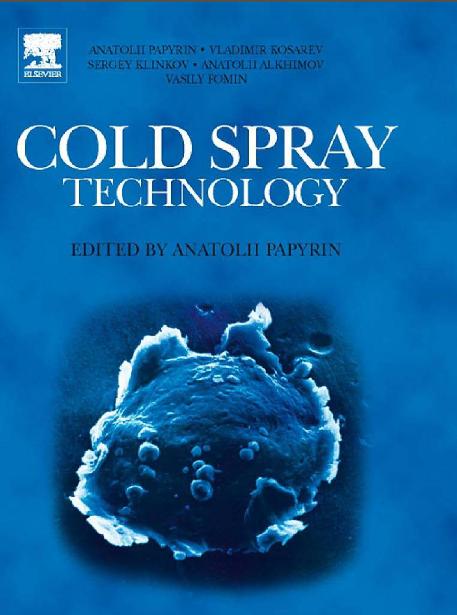
Cold gas-dynamic spray (or simply cold spray) is a process of applying coatings by
exposing a metallic or dielectric substrate to a high velocity (300–1200 m/s) jet of small
particles between 1-50 micrometer size accelerated by a supersonic jet of compressed gas. This process is
based on the selection of the combination of particle temperature, velocity, and size that
allows spraying at the lowest temperature possible. In the cold spray process, powder
particles are accelerated by the supersonic gas jet at a temperature that is always lower
than the melting point of the material, resulting in coating formation from particles in
the solid state. As a consequence, the deleterious effects of high-temperature oxidation,
evaporation, melting, crystallization, residual stresses, debonding, gas release, and other
common problems for traditional thermal spray methods are minimized or eliminated.
Eliminating the deleterious effects of high temperature on coatings and substrates offers
significant advantages and new possibilities and makes cold spray promising for many
industrial applications.